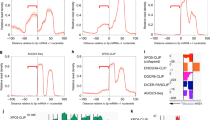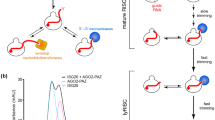Abstract
MicroRNAs (miRNAs) are a class of small, noncoding RNAs that function by regulating gene expression post-transcriptionally. Alterations in miRNA expression can strongly influence cellular physiology. Here we demonstrated cross-regulation between two components of the RNA interference (RNAi) machinery in human cells. Inhibition of exportin-5, the karyopherin responsible for pre-miRNA export, downregulated expression of Dicer, the RNase III required for pre-miRNA maturation. This effect was post-transcriptional and resulted from an increased nuclear localization of Dicer mRNA. In vitro assays and cellular RNA immunoprecipitation experiments showed that exportin-5 interacted directly with Dicer mRNA. Titration of exportin-5 by overexpression of either pre-miRNA or the adenoviral VA1 RNA resulted in loss of Dicer mRNA–exportin-5 interaction and reduction of Dicer level. This saturation also occurred during adenoviral infection and enhanced viral replication. Our study reveals an important cross-regulatory mechanism between pre-miRNA or viral small RNAs and Dicer through exportin-5.
This is a preview of subscription content, access via your institution
Access options
Subscribe to this journal
Receive 12 print issues and online access
$189.00 per year
only $15.75 per issue
Buy this article
- Purchase on Springer Link
- Instant access to full article PDF
Prices may be subject to local taxes which are calculated during checkout





Similar content being viewed by others
References
Bartel, D.P. MicroRNAs: genomics, biogenesis, mechanism, and function. Cell 116, 281–297 (2004).
Carthew, R.W. & Sontheimer, E.J. Origins and mechanisms of miRNAs and siRNAs. Cell 136, 642–655 (2009).
Ventura, A. & Jacks, T. MicroRNAs and cancer: short RNAs go a long way. Cell 136, 586–591 (2009).
Yi, R., Qin, Y., Macara, I.G. & Cullen, B.R. Exportin-5 mediates the nuclear export of pre-microRNAs and short hairpin RNAs. Genes Dev. 17, 3011–3016 (2003).
Lund, E., Guttinger, S., Calado, A., Dahlberg, J.E. & Kutay, U. Nuclear export of microRNA precursors. Science 303, 95–98 (2004).
Bohnsack, M.T., Czaplinski, K. & Gorlich, D. Exportin 5 is a RanGTP-dependent dsRNA-binding protein that mediates nuclear export of pre-miRNAs. RNA 10, 185–191 (2004).
Zamore, P.D. & Haley, B. Ribo-gnome: the big world of small RNAs. Science 309, 1519–1524 (2005).
Levy, C. et al. Lineage-specific transcriptional regulation of DICER by MITF in melanocytes. Cell 141, 994–1005 (2010).
Tokumaru, S., Suzuki, M., Yamada, H., Nagino, M. & Takahashi, T. let-7 regulates Dicer expression and constitutes a negative feedback loop. Carcinogenesis 29, 2073–2077 (2008).
Martello, G. et al. A MicroRNA targeting dicer for metastasis control. Cell 141, 1195–1207 (2010).
Yi, R., Doehle, B.P., Qin, Y., Macara, I.G. & Cullen, B.R. Overexpression of exportin 5 enhances RNA interference mediated by short hairpin RNAs and microRNAs. RNA 11, 220–226 (2005).
Brownawell, A.M. & Macara, I.G. Exportin-5, a novel karyopherin, mediates nuclear export of double-stranded RNA binding proteins. J. Cell Biol. 156, 53–64 (2002).
Calado, A., Treichel, N., Muller, E.C., Otto, A. & Kutay, U. Exportin-5-mediated nuclear export of eukaryotic elongation factor 1A and tRNA. EMBO J. 21, 6216–6224 (2002).
Gwizdek, C. et al. Exportin-5 mediates nuclear export of minihelix-containing RNAs. J. Biol. Chem. 278, 5505–5508 (2003).
Chen, T., Brownawell, A.M. & Macara, I.G. Nucleocytoplasmic shuttling of JAZ, a new cargo protein for exportin-5. Mol. Cell. Biol. 24, 6608–6619 (2004).
Gwizdek, C. et al. Minihelix-containing RNAs mediate exportin-5-dependent nuclear export of the double-stranded RNA-binding protein ILF3. J. Biol. Chem. 279, 884–891 (2004).
Macara, I.G. Transport into and out of the nucleus. Microbiol. Mol. Biol. Rev. 65, 570–594 (2001).
Köhler, A. & Hurt, E. Exporting RNA from the nucleus to the cytoplasm. Nat. Rev. Mol. Cell Biol. 8, 761–773 (2007).
Wang, Y., Zhu, W. & Levy, D.E. Nuclear and cytoplasmic mRNA quantification by SYBR green based real-time RT-PCR. Methods 39, 356–362 (2006).
Gwizdek, C. et al. Terminal minihelix, a novel RNA motif that directs polymerase III transcripts to the cell cytoplasm. Terminal minihelix and RNA export. J. Biol. Chem. 276, 25910–25918 (2001).
Zeng, Y. & Cullen, B.R. Sequence requirements for micro RNA processing and function in human cells. RNA 9, 112–123 (2003).
Boulon, S. et al. PHAX and CRM1 are required sequentially to transport U3 snoRNA to nucleoli. Mol. Cell 16, 777–787 (2004).
Zeng, Y. & Cullen, B.R. Structural requirements for pre-microRNA binding and nuclear export by Exportin 5. Nucleic Acids Res. 32, 4776–4785 (2004).
Grimm, D. et al. Fatality in mice due to oversaturation of cellular microRNA/short hairpin RNA pathways. Nature 441, 537–541 (2006).
Lu, S. & Cullen, B.R. Adenovirus VA1 noncoding RNA can inhibit small interfering RNA and MicroRNA biogenesis. J. Virol. 78, 12868–12876 (2004).
Mathews, M.B. & Shenk, T. Adenovirus virus-associated RNA and translation control. J. Virol. 65, 5657–5662 (1991).
Bhat, R.A. & Thimmappaya, B. Adenovirus mutants with DNA sequence perturbations in the intragenic promoter of VAI RNA gene allow the enhanced transcription of VAII RNA gene in HeLa cells. Nucleic Acids Res. 12, 7377–7388 (1984).
Han, J. et al. Posttranscriptional crossregulation between Drosha and DGCR8. Cell 136, 75–84 (2009).
Triboulet, R., Chang, H.M., Lapierre, R.J. & Gregory, R.I. Post-transcriptional control of DGCR8 expression by the Microprocessor. RNA 15, 1005–1011 (2009).
Satterly, N. et al. Influenza virus targets the mRNA export machinery and the nuclear pore complex. Proc. Natl. Acad. Sci. USA 104, 1853–1858 (2007).
Lund, E. & Dahlberg, J.E. Substrate selectivity of exportin 5 and Dicer in the biogenesis of microRNAs. Cold Spring Harb. Symp. Quant. Biol. 71, 59–66 (2006).
Hirt, B. Selective extraction of polyoma DNA from infected mouse cell cultures. J. Mol. Biol. 26, 365–369 (1967).
Acknowledgements
We are grateful to R. Kiernan and members of the Laboratoire de Virologie Moléculaire for helpful discussions and for critically reading the manuscript, and to G. Akusjärvi (Uppsala University, Uppsala, Sweden), B. Cullen (Duke University, Durham, North Carolina, USA) and I. Macara (University of Virginia, Charlottesville, Virginia, USA) for providing reagents. Work in M.B.'s laboratory was supported by Agence Nationale de Recherche sur le SIDA, SIDACTION, Agence Nationale de la Recherche-BLAN-0040, European Research Council (ERC 250333) and the Fondation pour la Recherche Médicale Equipe labéllisée FRM.
Author information
Authors and Affiliations
Contributions
Y.B. and M.B. planned and supervised the project and wrote the paper. Y.B. designed and performed most of the experiments with the help of C.C.-B. R.T. initiated the project. D.G. performed experiment in O.V.'s laboratory. C.G., C.D. and E.J.K. helped perform experiments and provided valuable reagents.
Corresponding authors
Ethics declarations
Competing interests
The authors declare no competing financial interests.
Supplementary information
Supplementary Text and Figures
Supplementary Figures 1–4 (PDF 7675 kb)
Rights and permissions
About this article
Cite this article
Bennasser, Y., Chable-Bessia, C., Triboulet, R. et al. Competition for XPO5 binding between Dicer mRNA, pre-miRNA and viral RNA regulates human Dicer levels. Nat Struct Mol Biol 18, 323–327 (2011). https://doi.org/10.1038/nsmb.1987
Received:
Accepted:
Published:
Issue Date:
DOI: https://doi.org/10.1038/nsmb.1987
This article is cited by
-
DICER: structure, function, and regulation
Biophysical Reviews (2021)
-
ETMR: a tumor entity in its infancy
Acta Neuropathologica (2020)
-
FTSJ3 is an RNA 2′-O-methyltransferase recruited by HIV to avoid innate immune sensing
Nature (2019)
-
Dicer functions as an antiviral system against human adenoviruses via cleavage of adenovirus-encoded noncoding RNA
Scientific Reports (2016)
-
Noncoding RNA as regulators of cardiac fibrosis: current insight and the road ahead
Pflügers Archiv - European Journal of Physiology (2016)



